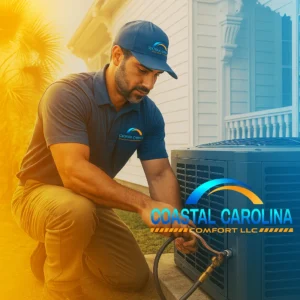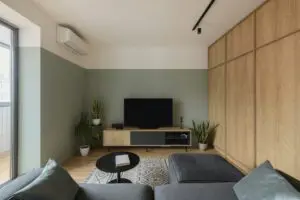Ever feel like your AC thermostat’s playing hard to get? Buttons stop flirting back, leaving you poking it for a sign of life. Or maybe it’s got a wild side, showing off incorrect temperatures like it’s auditioning for a weather channel spoof. Short cycling? It’s like it can’t decide on a relationship with your AC. And those energy bills are sneaking up like uninvited in-laws. When it won’t even turn on, it’s ghosting you, hard. Facing these mood swings? Your thermostat might be hinting it’s time for a change. Stick around, and we’ll uncover how to catch these curveballs.
Unresponsive Controls
When your AC thermostat acts more like a stubborn mule than a high-tech gadget, refusing to respond to your desperate pleas for cooler air, you know it’s time for a closer look. Ever noticed how those buttons you’ve been pushing, probably a little too aggressively, start to give up on you? That’s button wear for you — a classic tale of love and loss.
And let’s not forget the behind-the-scenes villain, wiring problems, secretly sabotaging your quest for comfort. It’s like your thermostat’s wires decided to throw a party and forgot to invite you.
You’re not alone in this. We’ve all been there, poking at our thermostats with a mix of hope and frustration, wishing for a sign of life.
Best Thermostat Replacements for AC Units
Incorrect Temperature Readings
Ever looked at your thermostat, felt the sweat on your forehead, and thought, ‘No way it’s only 75 in here’? You’re not losing your mind; your thermostat might just be on its own little adventure, courtesy of calibration errors, sensor malfunctions, or display issues.
Let’s crack into why your AC’s brain might be telling fibs about the temperature.
Calibration Errors
You know it’s going to be a long day when your AC thermostat thinks it’s chilling in the Bahamas while you’re shivering in your living room. It’s a classic case of calibration errors, where your thermostat’s sense of temperature has drifted further away from reality than a soap opera plot.
Facing temperature drift isn’t just annoying; it’s like playing a guessing game where the rules keep changing. And let’s not even get started on the adjustment difficulties. Trying to recalibrate your thermostat can feel like trying to teach a cat to high-five—frustrating and somewhat futile.
If you’re constantly battling with the controls, trying to find that sweet spot between too hot and too cold, it might be time to call in the pros. Because honestly, who wants to live in a home where the thermostat’s on vacation mode all year round?
Sensor Malfunctions
Diving into the world of sensor malfunctions, it’s like your thermostat’s playing a twisted game of ‘Guess Who?’ with your comfort levels. Suddenly, you’re sweating in a sweater or shivering in shorts, and you can’t help but wonder if your thermostat’s got a vendetta against you.
- Feeling like you’re in a sauna when you wanted an igloo? That’s a sign.
- Constantly nudging the temperature down only to bring a snowstorm inside? Yep, another red flag.
- Realizing sensor cleaning might just be the hero you need?
- Wondering if a simple battery replacement could stop this madness?
It’s time to reclaim your domain from the clutches of sensor rebellion, armed with a dust cloth and fresh batteries. Let’s make your thermostat a team player again.
Display Issues
When your thermostat starts playing charades with your temperature settings, it’s a clear signal that display issues are throwing a wrench in your indoor comfort. Imagine squinting at your thermostat, trying to decipher if it’s set for the Sahara or the Arctic, because the screen dimming has turned it into a guessing game.
And let’s not forget the psychedelic experience of color distortion, making you wonder if your thermostat suddenly joined a 60s rock band. It’s like trying to read hieroglyphics in a dimly lit room—a fun puzzle for an archaeologist, maybe, but not when you’re just trying to avoid turning your living room into a sauna or an igloo.
Time to call in the cavalry, because your thermostat’s display is clearly crying out for help.
Short Cycling Issues
Battling short cycling in your AC is like trying to tame a wild, temperature-flipping beast in your living room. It’s not just about the cycling frequency; it’s about keeping your cool—literally and figuratively. Now, don’t fret! Here’s what you can do:
- *Feel the frustration* of adjusting the settings every five minutes.
- *Laugh* at the absurdity of wearing winter clothes indoors.
- *Nod in agreement* with fellow sufferers in online forums.
- *Sigh in relief* at finding simple maintenance tips that might just do the trick.
Increased Energy Bills
Ever peeked at your energy bill and wondered if it’s trying to tell you you’ve won the lottery, but in reverse? You’re not alone.
Those skyrocketing figures could be a cry for help from your AC thermostat, hinting at accuracy issues or its secret mission to sabotage your efficient heating and cooling.
Unexplained Bill Surge
You know you’re in for a wild ride when your electricity bill skyrockets without warning, making you wonder if your AC has started a side hustle. Before you start accusing your air conditioner of moonlighting, consider some common culprits:
- Rate fluctuations: Sure, the power company loves to play with rates like a cat with a laser pointer.
- Seasonal adjustments: Winter called, and it wants its low bills back.
- That mysterious ‘always on’ setting: Did someone whisper eternal summer to your AC?
- Your thermostat playing hard to get: It’s not you, it’s definitely it.
When your bill gives you whiplash, it’s not just about the numbers. It’s about feeling like you’re part of a very expensive joke.
Thermostat Accuracy Issues
If your electricity bill’s been acting like it hit the jackpot, it might be time to side-eye your thermostat for accuracy issues. You know, when your home feels like a tropical paradise one minute and the Arctic the next, thanks to those delightful temperature fluctuations. Don’t even get me started on wiring problems. They’re like the invisible gremlins messing with your thermostat’s brain, making it go haywire and your bills through the roof.
It’s not just about the numbers climbing higher than your last vacation destination’s altitude. It’s about feeling like you’re part of a never-ending battle against your own home’s climate control. So, grab your detective hat and let’s get to the bottom of this thermostat saga before your wallet waves the white flag.
Efficient Heating/Cooling Loss
When your heating bill skyrockets faster than a penguin on a sled, it’s a clear sign your home’s playing a losing game of efficiency hide-and-seek. It mightn’t be just about wearing extra socks or blaming the weather gods. Your AC thermostat could be throwing a silent tantrum, causing your energy bills to soar. Here’s why you should care:
- *Room insulation* starts feeling like Swiss cheese—full of holes.
- *Ventilation efficiency* decides to go on a vacation, leaving you with stale air.
- Your wallet starts weeping silently in the corner, wondering where the good times went.
- Suddenly, your home feels more like a sauna or an igloo, with no in-between.
It’s not just about comfort; it’s about belonging in a space that understands the meaning of efficiency.
Thermostat Doesnt Power On
Staring at a thermostat that refuses to wake up is as fun as watching paint dry, isn’t it? You poke and prod, maybe even whisper sweet nothings, but it just sits there, unresponsive.
Before you start questioning your electrician skills, let’s dial it back to basics. Often, it’s a cry for a simple battery replacement. Yes, that little box on your wall might just be yearning for some fresh juice.
And if swapping batteries feels like you’re trying to fix a spaceship with a rubber band, fear not. The culprit could also be wiring problems – those invisible gremlins wreaking havoc behind the scenes.
Before you call in the cavalry (a.k.a. the professionals), checking these might save you from sweating bullets or, worse, an awkward family bonding over manual fans.
Erratic System Behavior
Occasionally, your AC decides to throw a tantrum, switching from Arctic chill to Sahara heat without warning, leaving you to wonder who flipped its mood switch.
When your AC displays more mood swings than a teenager, it’s likely signaling wiring problems or system restarts. Here’s what might be going on:
- System restarts more often than your computer on update day.
- Wiring problems make it act like it’s possessed.
- Sudden temperature changes leave you dressing for all four seasons in one day.
- Your energy bill spikes as if your home’s hosting an unseen all-day, all-night party.
This erratic behavior isn’t just frustrating; it’s a cry for help. Laugh through the tears, but remember, it might be time to call in the experts.
Frequently Asked Questions
How Can Humidity Levels Inside My Home Indicate a Problem With My AC Thermostat?
If your place feels more like a jungle than a home, it’s time to check your thermostat’s calibration. Incorrect humidity measurements can be a sneaky sign you’re in for some thermostat troubleshooting!
Can Frequent Power Outages Affect the Lifespan or Functionality of My AC Thermostat?
Absolutely, frequent power outages can throw your AC thermostat’s life off balance. Think of it as riding a rollercoaster without a seatbelt! Surge protection and battery backups are your best friends in keeping it steady.
Are There Any Specific Thermostat Brands or Models Known for Their Reliability and Fewer Repair Needs?
Yes, some thermostat brands really stand out for being low-maintenance heroes. You’re looking at brands riding the wave of thermostat trends and innovation, making your life easier and your wall tech-savvy without the constant TLC.
How Does the Placement of My Thermostat in the House Impact Its Performance and the Need for Repairs?
Like Goldilocks, your thermostat’s spot can’t be too hot or too cold. Placement efficiency matters! Wrong spots lead to temperature fluctuations, making it seem like you need repairs more often than you actually do.
What Are the Environmental Factors Inside My Home That Can Contribute to the Degradation of My AC Thermostat’s Accuracy Over Time?
Dust bunnies and wild temperature swings in your pad can mess with your AC thermostat’s vibe, making it less accurate. You’re not alone in the struggle to keep it chill and precise, friend.
Conclusion
Well, there you have it, folks. If your AC thermostat‘s acting more mysterious than your teenager’s mood swings, it might be time to show it the door.
Did you know that a wonky thermostat can cause a 20% hike in your energy bills? That’s enough to fund your coffee addiction for months!
So, if you’re noticing any of these quirky behaviors, it’s probably begging for a retirement party. Give it a send-off and welcome a new gadget into your life. Your wallet will thank you.


